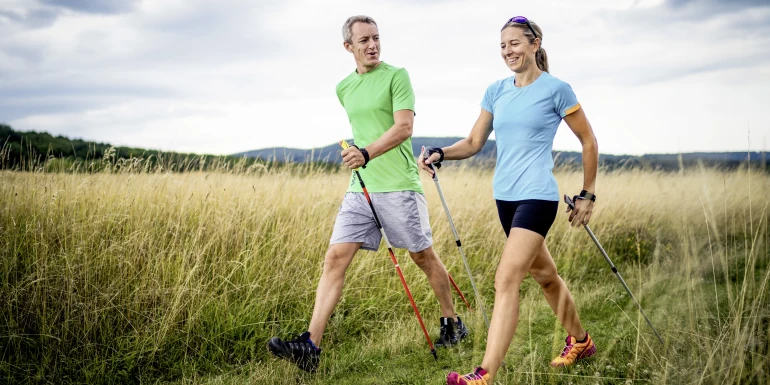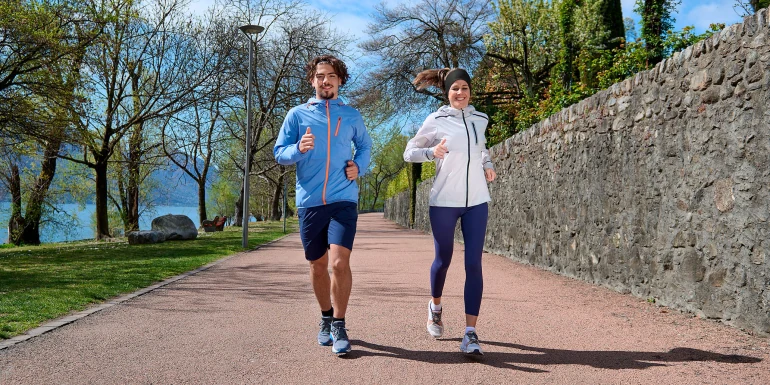
Walking and running
Walking, Nordic walking and running are easy to learn and can be practised almost anywhere. Whether walking at a brisk pace while actively swinging your arms, using special poles for Nordic walking, or basic running – the positive effects are many and varied. These sports help you improve your strength and fitness, and thus prevent cardiovascular disorders.
Running and walking take up time, but cost very little compared to other sports. Appropriate footwear, functional clothing and special poles for Nordic walking are all you need to start striving for those personal bests.
Wearing the correct shoes is key, and everyone's feet are different. In addition to foot shape, running style, body weight and preferred terrain are important when choosing the ideal sports shoe. It's therefore a good idea to visit a specialist store and seek advice from a trained member of staff.
As a rule of thumb, lightweight shoes without supportive elements should only be used by runners who are light on their feet and do not suffer from foot injuries. When trying on shoes, wear your running socks and make sure you have enough room for your toes (rule of thumb: shoe size plus 1 cm).
Besides functional running or walking shoes, you also need appropriate socks. The key thing to remember when it comes to clothing is layers. If all your clothing is made of breathable microfibre, you will be perfectly protected against overheating and hypothermia. On cold days, gloves and a headband or hat ensure that as little body heat is lost as possible.
The right technique
By employing the correct technique, you can run economically (i.e. save energy) and protect yourself against injuries. Running style partly depends on your physique, but can almost always be improved.
The following five principles should help you run correctly.
1. Purposeful movements
All movements of arms, legs, head and torso should be aimed at direct forward motion. Sideways movements (such as rotation of the torso or excessive arm movements) use up additional energy.
2. Upright head
Head control is a key principle of running. Head position guides the posture for the rest of the body. Ensure first and foremost that your head and cervical spine are straight, upright and relaxed.
3. Upright torso
The torso should be upright and the spine elongated. This creates space for the lungs, heart and large blood vessels – and will protect your back.
4. Correct arm movement
Arm movements should aid balance, even out any rotation of the torso, and at the same time use as little energy as possible. The arms should pivot on a horizontal axis through the shoulder joint. The elbow joint should be held at a right angle, with wrist and hand relaxed. The elbows and hands should hardly move at all.
5. Feet and pace
You should land with your feet pointing forwards in the direction you are running. Your stride should be brisk but not too long.
Running uphill
Special rules apply if running off-road. If running uphill, shorten your stride depending on the steepness of the slope and push off more with your feet. Swing your arms vigorously. The upper body should lean slightly further forward than when running on flat ground.
Running downhill
When running downhill, it is easiest and most efficient if you slide into your stride, rather than slowing your momentum at every step. Land on the outer edge of your full foot. It is particularly important to avoid forced rolling over the heel when running downhill (applies to joggers only). The arms should be used to generate additional balance, by holding them less closely to the body. The upper body should lean backward a little further than when running on flat ground.



Newsletter
Find out more about current health issues every month and get all the information you need about our attractive offers from all Helsana Group companies * delivered by e-mail to read whenever it suits you. Our newsletter is free of charge and you can sign up here:
We did not receive your information. Please try again later.
* The Helsana Group comprises Helsana Insurance Company Ltd, Helsana Supplementary Insurances Ltd and Helsana Accidents Ltd.